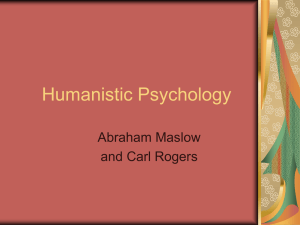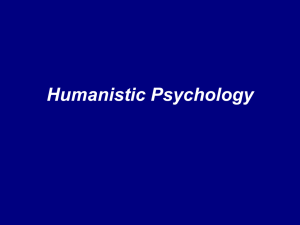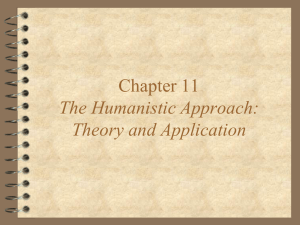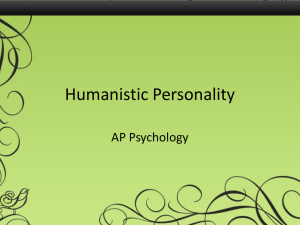Chapter 11 The Humanistic Approach: Theory and Application
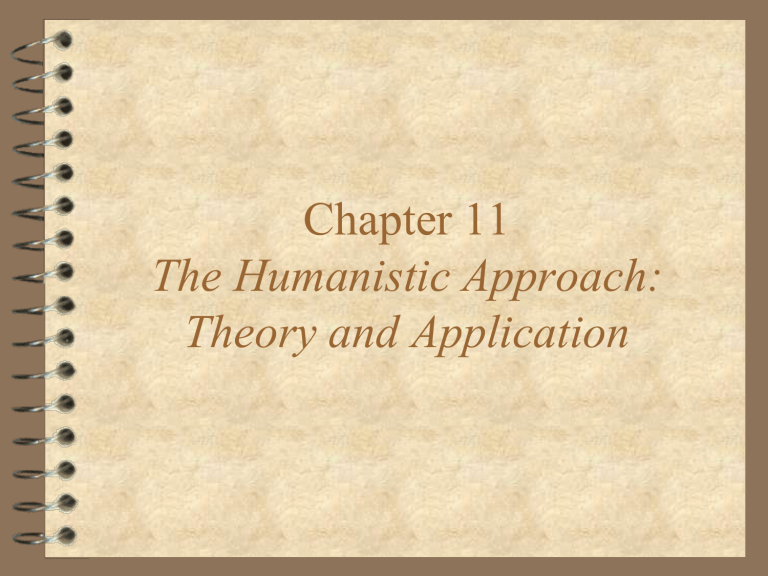
Chapter 11
The Humanistic Approach:
Theory and Application
The roots of humanistic psychology
Humanistic psychology has been called the “third force” in
American psychology, with psychoanalysis and behaviorism representing the first two “forces.”
Humanistic psychology has its roots in existential philosophy, which was proposed and explored by a number of European philosophers in the early decades of the 20 th century.
Humanistic psychology also owes a great deal to the work of three American psychologists: Carl Rogers, Abraham Maslow, and Fritz Perls.
Existentialist philosophers: Nietzsche,
Kierkegaard, Husserl, and Sartre
Key elements of existentialist philosophy
We have no choice regarding the life circumstances into which we are born.
After achieving self-awareness and an understanding of the world, we can‒and must‒begin to make meaningful choices.
Existential anxiety is a major fact of human existence.
The only meaning that life has is the meaning that we confer on it through the choices we make. We are all “lonely heroes” who must choose without fully knowing the consequences of these choices.
We may attempt to avoid making choices and accepting responsibility, but if we do, we are displaying “bad faith.”
People attempt to escape choice and responsibility in different ways: by turning our lives over to other people, by trying to live in the past or in the future, by letting our habit patterns take over, or by using addictions as a buffer against existential anxiety.
The roots of humanistic psychology
Humanistic psychology has been called the “third force” in
American psychology, with psychoanalysis and behaviorism representing the first two “forces.”
Humanistic psychology has its roots in existential philosophy, which was proposed and explored by a number of European philosophers in the early decades of the 20 th century.
Humanistic psychology also owes a great deal to the work of three American psychologists: Carl Rogers, Abraham Maslow, and Fritz Perls. Other prominent existential psychologists include Viktor Frankl, R.D. Laing, and Rollo May.
Humanistic psychologists: Carl Rogers,
Abraham Maslow, and Fritz Perls
Key elements of the humanistic approach
Personal responsibility
The here and now
The phenomenology of the individual
Personal growth
Carl Rogers (1902-1987)
Grew up in a repressed Midwestern farm family in which the open expression of emotion was discouraged
Planned a career in agriculture, but changed his mind and went to study for the ministry at
Columbia University
Took graduate courses in psychology while at
Columbia and received his Ph.D
Taught at Ohio State, the University of
Chicago, and the University of Wisconsin
Received a Distinguished Scientific
Contribution Award from APA in 1956
Moved to LaJolla, California in 1963, where he founded the Center for Studies of the Person
Key concepts introduced by Rogers
The fully functioning person
, Rogers’ term for people who:
– are open to their experiences
– try to live each moment as it comes
– trust their own feelings and intuitions
– are less likely to conform to societal roles or other people’s expectations
– follow their own interests and decide what’s best for themselves
– experience their feelings deeply and intensely
Anxiety and defense through subception , distortion , and denial
Conditions of worth
– conditional positive regard
– unconditional positive regard
Conditional positive regard
Abraham Maslow (1908-1970)
Had a lonely childhood as a Jewish boy in a non-Jewish neighborhood
Tried law school at City College in New York, then transferred first to Cornell and then to
Wisconsin, where he became an enthusiastic behaviorist
Worked with Harry Harlow at Wisconsin and then worked with E.L. Thorndike at Columbia
University
Became disillusioned with behaviorism with the birth of his first daughter
Taught at Brooklyn College, where he met
Horney, Fromm, Adler, Benedict, and
Wertheimer, and decided to study the “selfactualized personality”
Taught at Brandeis from 1951 until shortly before his death in 1970
Maslow’s hierarchy of human needs
Four common misconceptions about
Maslow’s need hierarchy
The order in which people seek to satisfy these needs is fixed and invariant.
The needs at a lower level on the need hierarchy must be satisfied 100% before the person will begin to seek to satisfy a higher-order need.
The way that people satisfy a particular need is the same in all cultures and in all historical periods.
Any given behavior is motivated by one and only one need.
As common misconceptions, all of these beliefs are false .
Maslow’s study of psychologically healthy people
Maslow used what he called “holistic analysis” to identify the following set of characteristics that were common to seemingly self-actualized people such as Thomas Jefferson, Albert Einstein, Eleanor Roosevelt, and
Albert Schweitzer. According to Maslow, they are people who:
– both reality-centered and problem-centered
– tend to accept themselves for who and what they are
– are less restricted by cultural norms and conventions than the average person
– display self-actualizing creativity in the way they live their lives
– have relatively few friends, but their friendships tend to be deep and rewarding ones
– have a philosophical and non-hostile sense of humor.
– have a strong need for solitude and are comfortable being alone
– express a strong appreciation for life’s experiences
– are more likely to be aware of “peak experiences” and to experience them more intensely than the average person does
A literal “peak experience”?
Mihalyi Csikszentmihalyi’s concept of optimal experience
Using beeper (electronic pager) studies,
Csikszentimihalyi and his colleagues found that people’s most rewarding and engaging experiences were typically work-related.
These optimal experiences could be characterized by a state called flow .
Csikszentimihalyi proposed a set of eight features that contribute to the sense of flow.
It isn’t necessary for all eight features to be present for a person to experience flow, but most, if not all, of them will typically be present.
Eight features of flow that characterize optimal experiences
The activity is challenging and requires skill.
One’s attention is completely absorbed by the activity.
The activity has clear goals.
There is clear feedback.
One can concentrate only on the task at hand.
One achieves a sense of personal control.
One loses self-consciousness.
One loses a sense of time passing.
Optimal experience and happiness in everyday activities
According to Czikszentmihalyi, personal happiness comes from taking responsibility for our own life and finding meaning and enjoyment in our ongoing experiences.
Although optimal experiences are reported during play and recreational activities, they are most often reported during work hours.
Work that challenges us and tests the limits of our ability and creativity is the most rewarding, because it can fulfill our needs on multiple levels.
In one study, high school students who took classes for intrinsic, rather than extrinsic reasons, found the learning process more satisfying and enjoyable, and reported that, subjectively, the time involved passed more quickly.
Application: Job satisfaction and the hierarchy of human needs
Most of us will spend many, if not most, of our waking hours at work.
For us to be satisfied with how this time is spent, our jobs need to provide more than a steady paycheck; ideally, they should help us meet most, or even all, of the needs in
Maslow’s need hierarchy.
Maslow therefore promoted what he called Eupsychian management―restructuring a work organization to help employees satisfy higher-order needs.
Maslow’s hierarchy of human needs
Application: Person-centered therapy
Carl Rogers argued that therapy should be non-directive and “personcentered” because therapists cannot understand clients as well as they understand themselves.
Therapists should create the optimal environment in which clients can heal themselves. Specifically, this environment requires:
–
Genuineness
–
Empathy
–
Unconditional positive regard
–
Opportunities for reflection
– Resisting the temptation to tell clients what they really mean to say
Therapists can use the Q-sort technique to assess how the client’s selfperceptions change over the course of the therapy.
Distribution of cards in Block’s Q-Sort
Examples of Q-sort items
Is a talkative individual
Behaves in a sympathetic or considerate manner
Initiates humor
Prides self on being “objective,” rational
Seeks reassurance from others
Is productive, gets things done
Has high aspiration level for self
Able to see to the heart of important problems
Is cheerful
Values own independence and autonomy
Is calm, relaxed in manner
Distribution of cards in Block’s Q-Sort
Degrees of overlap (perceived discrepancies) between the real self and the ideal self
Changing real and idea self Q-sorts for a
40-year-old female client (Rogers, 1954)
Degrees of overlap between the real self and the ideal self
Strengths and criticisms of the humanistic approach
Strengths
–
This approach was the first to emphasize the healthy side of human personality, and it set the stage for what is now called positive psychology
(the psychology of happiness, forgiveness, etc.).
– It has had a huge impact on the way psychologists and counselors approach therapy.
– It has also had a strong and continuing influence in disciplines such as education, communication, and business.
Criticisms
–
Its insistence on free will seems to be incompatible with a deterministic view of science, in which all actions can be reduced to physical causes.
– Many key concepts, such as “self-actualization,” “fully functioning” and
“peak experience” are not well-defined.
– Humanistic psychotherapy techniques may have limited applicability.
– Humanistic psychologists may make overly naïve assumptions about human nature.
